 This review is part of the Cameras of the Dead series which I have been publishing every year on Halloween and “Halfway to” Halloween, featuring three cameras that I’ve wanted to review that either didn’t work, or was otherwise unable to shoot.
This review is part of the Cameras of the Dead series which I have been publishing every year on Halloween and “Halfway to” Halloween, featuring three cameras that I’ve wanted to review that either didn’t work, or was otherwise unable to shoot.
I am republishing each of those individual reviews this October in anticipation of this Halloween’s Cameras of the Dead post as a way to revisit the cameras of the past that allows them to be properly indexed on the site.
This is a Polaroid Land Camera model 95 which was designed by Dr. Edwin Land, and was the first successful implementation of a self-developing ‘instant’ film camera. Although other companies successfully marketed and sold instant cameras, the name “Polaroid” became synonymous with instant photography in the second half of the 20th century. The 95 is a very large camera that uses an early form of instant roll film that would be pulled from the camera one exposure at a time. Development time was a little over a minute which was slow by later instant film standards, but revolutionary when first introduced in 1948. The 95 used Polaroid 40-series film which was discontinued in 1992 and there are no modern equivalents to shoot with this camera. It is possible to modify the Land Camera model 95 to use other types of roll film or instant sheet film, but that’s not something that I have taken the time to do.
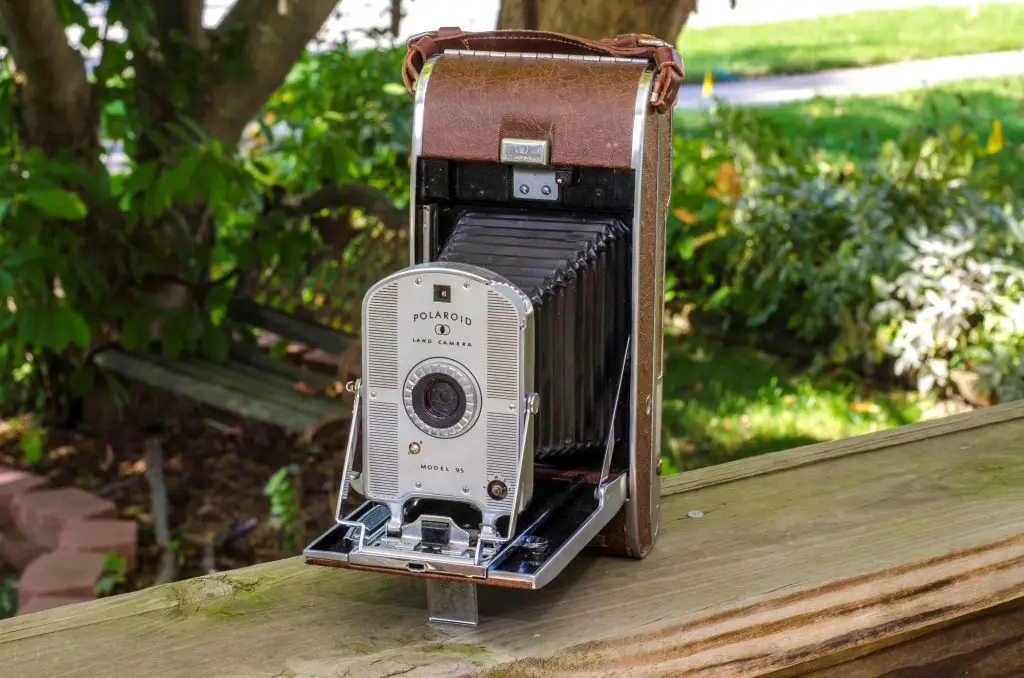 Film Type: Polaroid 40-series Instant roll film
Film Type: Polaroid 40-series Instant roll film
Lens: 135mm Polaroid f/11 coated 3-elements
Focus: 4 feet to Infinity
Viewfinder: Flip Up Optical Viewfinder
Shutter: Polaroid Rotary Leaf
Speeds: B, 1/8 – 1/60
Exposure Meter: None
Battery: None
Flash Mount: M and X sync via ASA port and proprietary two pin connector
Weight: 1938 grams
Manual: http://www.cameramanuals.org/polaroid_pdf/polaroid_95a_95b_700.pdf
History
Although the company no longer makes cameras or film anymore, the name “Polaroid” is still widely recognized as a type of instant film camera much in the same way that any type of facial tissue is often called a “Kleenex”, or how photocopiers are often called “Xerox” machines regardless of who made them. If you were born prior to 1990, the chances are extremely high that at least once in your life, your photo was taken by a Polaroid camera.
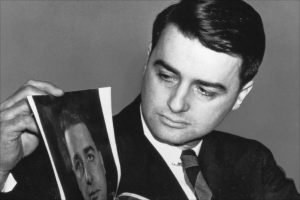
How it all began is a pretty fascinating story, led primarily by an even more fascinating man, named Dr. Edwin Land who Wikipedia suggests was the Steve Jobs of the mid 20th century due to his visionary ideas and groundbreaking patents. Dr. Land once studied chemistry at Harvard University before dropping out of school after his freshman year to pursue development of polarizing light filters. Together with his Harvard physics instructor, George Wheelwright, they both formed the Land-Wheelright Laboratories in 1932. The company would later be renamed the Polaroid Corporation in 1937.
Polaroid’s original patents were for a light polarizing film called ‘Polaroid film’, which was used in the manufacturing of glare reducing sunglasses, 3D projection, and during WWII, night vision devices. In total, Dr. Land is credited with 533 US patents, which is second highest by any one person, only to Thomas Edison.
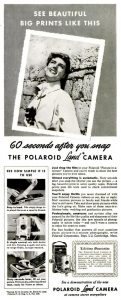
Polaroid was already quite successful by the end of World War II, but it wouldn’t be until 1948 that the company would release it’s most game changing product, the instant film camera. Like Kodak, Polaroid was a “film first” company and only made cameras as vessels to consume film. Polaroid’s instant film required a camera to use it, and as a result, the Polaroid Land Camera Model 95 was born. There is a rumor that the number “95” was chosen because that was the price the camera was said to sell for, but period advertisements show the camera often selling for right around $100, so I am not sure if that’s just a rumor of convenience, or if there is some truth to it.
Polaroid would outsource construction of the earliest Model 95s to other US companies like Wollensak, Bell & Howell, Samson United of Rochester, NY, and possibly even the Timex Corporation out of Atlanta, GA. The Model 95 used a new type of Polaroid instant film that would sandwich light sensitive negative and positive layers between a reagent chemical that when exposed to light, would transfer and develop an image from the negative to the positive side. The positive side would be removed from the camera and would serve as the photograph. The total time to develop an image was right around 1 minute, but would vary depending on outside temperature and film stock used.
The Polaroid Land Camera was extremely successful with the original model selling well over a million copies. In the decades that followed, Polaroid would release many different models and film formats, reaching the peak of their popularity in the late 1970s, with an estimated 21,000 employees and sales in the millions of units. Although functioning as CEO, Edwin Land considered himself first and foremost a scientist and inventor. He was also an avid humanitarian tackling often controversial issues such as employing women as research scientists and taking an active role in the affirmative action movement after the assassination of Dr. Martin Luther King.

Although Polaroid’s consumer cameras were the bread and butter of the company’s sales, their products consisted of more proprietary and sometimes very large room sized cameras. Polaroid’s largest film had an exposed size of 20 x 24 inches. Originally introduced in 1977 at the Polaroid share holder’s meeting, the massive 20×24 camera was a sliding view camera with huge red bellows, and shot massive 150 foot long rolls of film. A total of six 20×24 cameras were ever made and originally were intended to be used without charge, by artists who would only pay for the film, and the understanding that Polaroid could use the images.
Many famous artists and subjects have used or been photographed using 20×24 Polaroid film due to it’s massive size and instant results. There has been no other camera ever made with the size and instant gratification as the 20×24 Land Camera. Sadly, as of 2009 the film needed to use the 20×24 camera was discontinued, and existing supplies are expected to run out by early 2017 at which point, the last 20×24 image will ever be taken.
Dr. Edwin Land would run his company until his retirement in 1981 and although the Polaroid Corporation would live on in his absence, the company’s pioneering days of innovation would be over. Polaroid would stumble into the 21st century and would not survive the arrival of digital photography. In 2001, the original Polaroid Corporation would file for Chapter 11 bankruptcy and although a Polaroid holding corporation would continue to operate and make Polaroid film, the new company would cease all film manufacturing in 2009 relegating the Polaroid brand to a marketing name applied to various products made by other companies.
My Thoughts
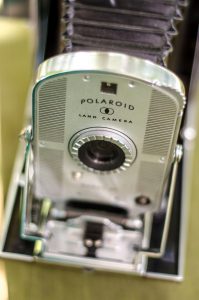
Throughout my journey collecting old cameras, I can say that Polaroid cameras were just not something I ever had an interest in. For one, the film is very hard, if not “impossible” (heh, heh, get it?) to find. In addition, most Polaroid cameras aren’t very attractive and just never appealed to me. So, when this Land Camera fell into my lap, I thought it was kind of cool looking, and the fact that it was the original Model 95 from around 1948 meant that I could at least pride myself in owning a historically significant camera, even though I would likely never use it.

The camera sat in a the lower shelf of the liquor cabinet that I display my cameras in for months before realizing that it might make a good addition to my Cameras of the Dead series. Yet unlike every other camera in this series, this one actually works. The camera is in nice cosmetic shape, the bellows appear to be light tight, the shutter seems to work at all speeds, and the lens is free from fungus, haze, or major scratches.
Since I couldn’t use it however, I figured why not include it, so this began my efforts to throw together enough information to include it as an official “dead” camera. But a funny thing happened. As I handled the camera and looked at it enough to figure out how it might have worked, it’s bulbous size started to grow on me. The fake brown leather covering is quite nice. It has a very custom saddle tan appearance and texture that really compliments the brushed aluminum body. Whenever I review a camera, I generally take it out for some “glamour” shots for the review, but as I was photographing this camera, I started to grow more and more appreciative of it’s looks.
Then I read a little about it’s history and learned more about Edwin Land, and his contributions to photography, and how innovative the entire Polaroid company was, and before I knew it, I found myself fascinated with this thing. Sure, it’s a hulking whopper of a chunk of metal, but I can’t help but be amazed at how it was designed. This thing really is beautiful, and unlike most cameras where 5 – 6 shots are good enough for a review, I found myself with over 30 different shots that all looked great. I narrowed those down to just the best 14 and since this review isn’t long enough for me to scatter them throughout like I usually do, I decided to add a little gallery of the extra shots that I took.
Using the Camera
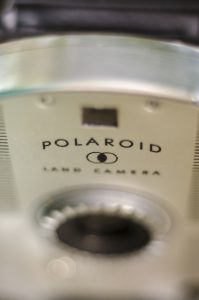
The Polaroid Land Camera Model 95 is an impressive device to look at, standing a full 24 cm (~9.5 inches) tall and weighing in at 1938 grams (~4.27 lbs), it is very large and very heavy. Much larger than any other folding camera I own.
The extra size was needed to house the complex system of rollers need for the instant film to work. Unlike “regular” roll film cameras that use light sensitive negative or positive film, the Polaroid needed to have both a positive and a negative sheet, with developing chemicals sandwiched between. To expose an image, the negative layer must first be separated and run across the film plane. Firing the shutter exposes the negative side of the film only.
Simply firing the shutter does not begin the development process. After firing the shutter, you must release a film catch, open a small metal door on the side of the camera which exposes a small paper tab which you pull out of the camera. Once you’ve pulled the paper tab out of the camera, you have moved the exposed negative to a position in which it has come in contact with the positive paper and development chemicals.
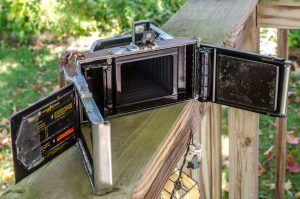
At this point you wait for the image to develop. Most film of the day took a full minute for the developing to complete, but this time varied with ambient temperature and with other types of film that became available over the years.
Once an adequate amount of time had elapsed, you would open a secondary door on the rear of the camera which exposes the back of the positive image. The positive image has perforations in the paper which you must tear with your fingers to separate the positive from the negative image. These perforations are why all Polaroid prints from this camera have a unique serrated edge to them.
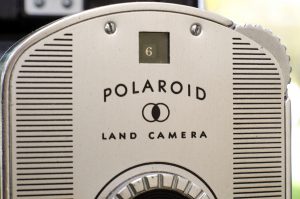
If this sounds confusing, don’t worry, it is. The camera has a total of 3 doors to open for loading and unloading film. There are no shutter speeds or aperture numbers anywhere on the camera. Instead, there was a dial, numbered 1-8 that would change shutter speed and iris size to correspond to a variety of lighting situations.
This is definitely a camera in which you need to read the manual to familiarize yourself with before you even think about shooting with it (assuming film was available…which it’s not). But before you can do any of this, you need to load film in it.
Since film for these cameras is not made anymore, I can’t show you how to do it, since I’ve never done it myself. There are a few videos on Youtube that show how to load film into a 95 series Land Camera, but most of them are either very poorly recorded, blurry, or entirely in Russian. I found the following video below which is done on a Model 800 Land Camera which is very similar to the Model 95. The camera looks different, but they use the same film and load in a similar manner.
I’d love to explain more about how this fascinating camera worked, but without any film, it is just not possible.
Since this is a camera from the dead, I wont have any images to show you, but I managed to run across a fellow camera enthusiast named Bernard Wilson who owned a Model 95 back in the 1970s and he offered to send me some scans of images he took with his.
Bernard granted me permission to share his images here, and since I can’t shoot my own, here are actual scans from what he describes as the late 1970s near Seattle, WA.
Related Posts You Might Enjoy
External Links
http://camera-wiki.org/wiki/Polaroid_Land_Model_95
http://www.landlist.ch/landlist/landdcam-roll.htm#95
https://vintagecameralab.com/polaroid-land-model-95a/
https://www.youtube.com/watch?v=Lg271TDD4Mc
https://petapixel.com/2015/06/11/the-history-and-magic-of-instant-photography/

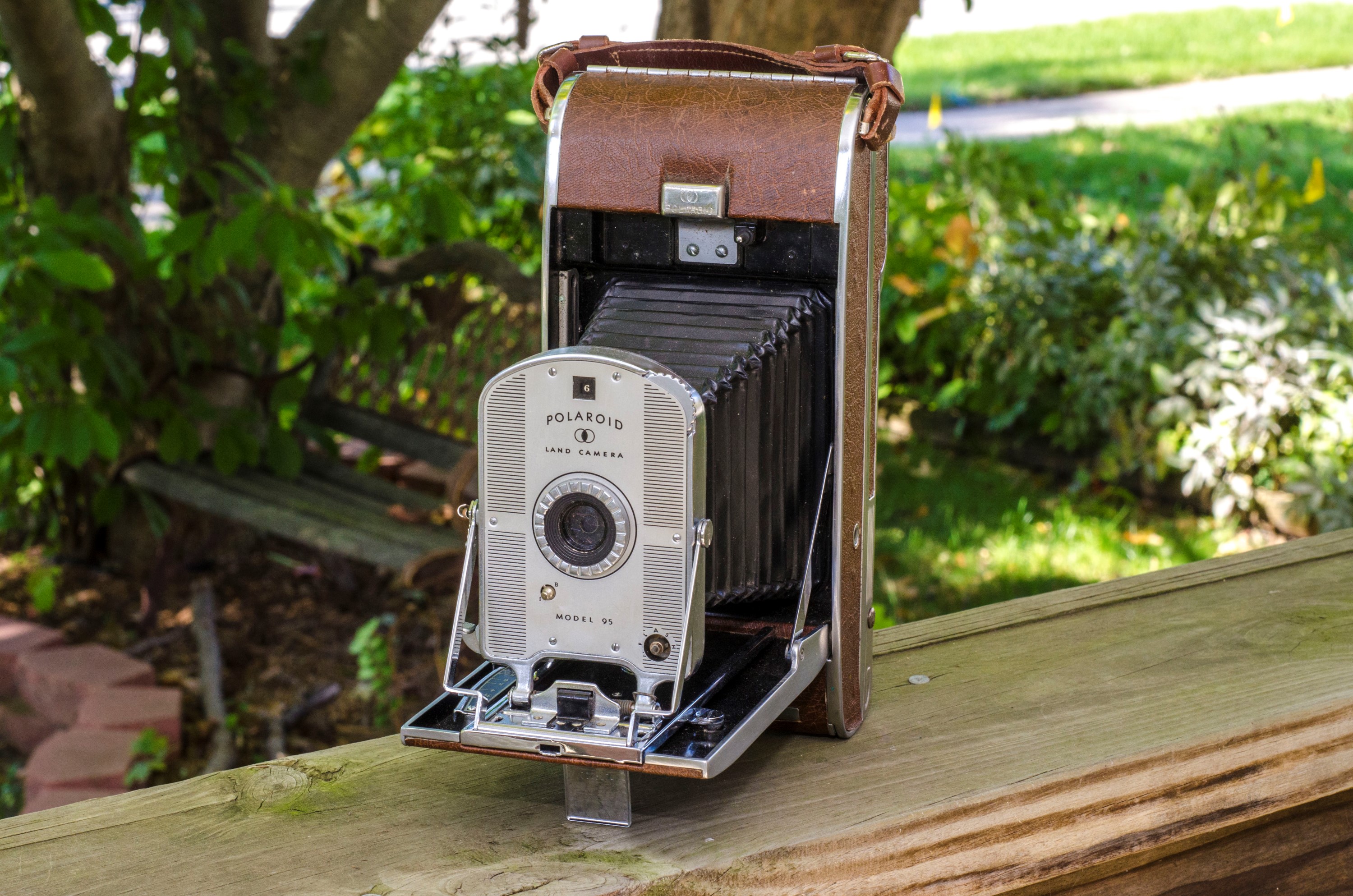
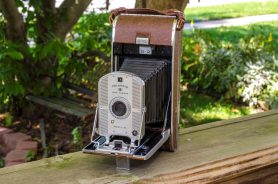
















A later model (New “small” size and 10 seconds) was demonstrated in numerous live commercials on the old “I’ve Got a Secret Show” and I think perhaps “To Tell the Truth”. This attractive lady took a photo on the spot and showed how “easy” it was to use the camera. At least she made it look easy. Here is one of those TV ads: https://www.youtube.com/watch?v=LCOvKngmLyI . I’ve seen a number of these in re-runs and every time she and the camera performed perfectly.
Noah Henderson of “Analog Resurgence” shoots Polaroid series 40 roll film: https://www.youtube.com/watch?v=UMP6Wf9nvuk
Believe the camera had to weight 4lbs to avoid a tax at the time. Got that from ‘A Triumph of Genius: Edwin Land, Polaroid, and the Kodak Patent War’ Book.
Extremely well explained and reminds me of the way I used to load my 95 model back in the 1980 I still own the camera standing proud in my large collection of cameras